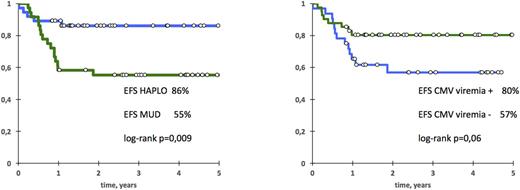Abstract
ObjectivesHematopoietic stem cell transplantation is a standard component of curative therapy for high-risk and relapsed acute myeloid leukemia (AML) in children. Over the recent years selective depletion of alpha/beta T cells from the graft evolved as a powerful method to decrease graft-versus-host disease incidence and associated treatment-related mortality, while maintaining high anti-leukemic activity. We report here the results of the alpha/beta T cell-depleted HSCT in a cohort of pediatric patients with high-risk or relapsed AML transplanted in complete remission from either haploidentical or matched unrelated donors.
Methods Seventy-three patients with AML were transplanted in CR1 (n=59) or CR2 (n=14) from haploidentical (n=37) or MUD (n=36) donors, between May 2012 and September 2016. Median age at Tx was 6,8 years, male/female ratio of 26/47. Preparative regimen included fludarabine, treosulfan and either melphalan (n=59) or thiotepa (n=14). Serotherapy and post-transplantation GVHD prophylaxis included one of the following: regimen 1) ATG (horse) +/- methotrexate +/- tacrolimus (n=25); regimen 2) ATG (rabbit) + bortezomib (days -5,-2,+2,+5) + rituximab (n=47). All grafts were derived from G-SCF-mobilized PBSC, depleted of alpha/beta T cells and CD19+ B cells.
Results All but one patient engrafted at a median of 13 days for ANC and 14 days for platelets. The cumulative incidence of aGVHD grade 2-3 was 25(+/-6)%, chronic GVHD - 22(+/-5)%, extensive chronic GVHD - 7(+/-3)%, without difference between donor types. Among all patients transplant-related mortality is 10(+/-4)%, cumulative incidence of relapse is 20(+/-5)%. Relapse incidence after haplo - 9(+/-5)% was significantly less than after MUD HSCT 31(+/-8)%, p=0,02. At a median follow-up of 2,6 years, event-free survival is 70(+/-5)% and overall survival is 75(+/-5)%. Bivariate analysis suggests that the use of haploidentical donors significantly improves survival, EFS Haplo 86(+/-5)% vs MUD 55(+/-8)%, p=0,009. CMV viremia was significantly associated with decreased incidence of relapse, CI of relapse of 33(+/-8)% in those without CMV viremia vs 9(+/-5)% in those with CMV viremia, p=0,02 with a trend to improved event-free survival, EFS in CMV viremia"+" - 80(+/-6)% vs CMV viremia"-" 57(+/-9)%, p=0,07.
Conclusion Our retrospective analysis suggests that chemotherapy-based conditioning and alpha/beta T cell depletion are associated with highly favorable results in a cohort of pediatric patients with high-risk AML transplanted from haploidentical donors. Specific to this graft processing platform CMV reactivation appears to boost anti-leukemic activity of the graft without increasing transplant-related mortality
Maschan: Miltenyi Biotec Gmbh: Honoraria.
Author notes
Asterisk with author names denotes non-ASH members.


